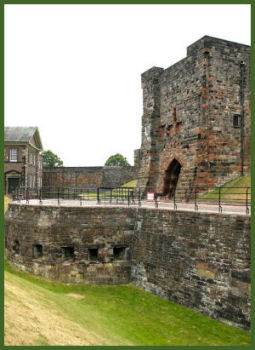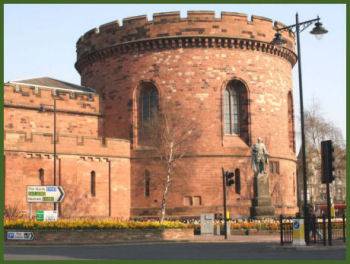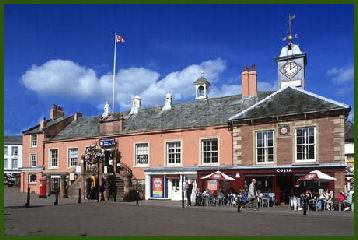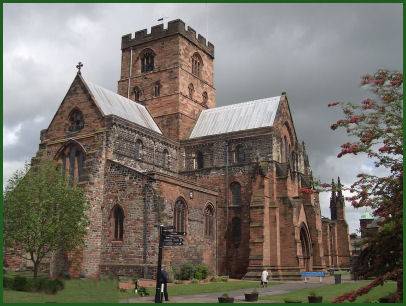Carlisle
OS Grid ref:- NY 403556
By tradition the ancient city of Carlisle can be considered as one of the guardians of northern England. Carlisle is the largest urban area in Cumbria and its only city.
The city was established by the Romans to serve the forts along Hadrian's Wall and was known to them as Luguvalium, Luguvalium derives from the Latin "the place, or wall (stronghold) of Lugus. Lugus was a local deity. The modern name derives from Caer (castle) Luel or Llewelyn. Luel is Celtic personal name. The local dialect is a diasystem of the Cumbrian dialect which can be found across much of north-east of the county.
Carlisle Castle
 Carlisle Castle sits on a grassy hill above the confluence of the rivers Eden and Caldew.
The castle is approached along a cobbled way guarded by a gatehouse which still retains its portcullis.
Carlisle Castle sits on a grassy hill above the confluence of the rivers Eden and Caldew.
The castle is approached along a cobbled way guarded by a gatehouse which still retains its portcullis.
The castle now serves as the headquarters of the King's Own Border Regiment and contains the regiment's museum. Buildings known as Arnhem, Ypres, Gallipoli, and others named after the regiments various campaigns flank the central courtyard. Visitors can explore its ancient chambers, stairways and dungeons.
Carlisle Castle boasts a long and colourful history, it was founded by King Willliam II, known as Rufus, the third son of William the Conqueror, during a campaign in the north to drive out Dolfin, son of Earl Gospatrick of Northumbria, William built the first timber castle on the site in 1092.
More on Carlisle Castle and its history

Carlisle boasts an excellent shopping centre, a choice of restaurants, bars and cafes, a superb central museum and an art gallery as well as a wide range of accomodation to suit all budgets.
In the medieval era, the city walls of Carlisle joined with the castle defenses to create a continuous defensive barrier. The walls were built in the eleventh century by William Rufus, the son of William the Conqueror. The city was besieged during the Civil War, but the walls were in strong enough state to withstand an extended assault. The Royalist defenders were finally induced to surrender by starvation. A section of the walls, known as the West Walls, stil survive and include the Sally Port, a defensible doorway designed to be used in the event of a siege.
The Citadel, with its round, squat, battlemented towers and walls of red sandstone was built in the reign of King Henry VIII. Two large oval towers which once formed the southern entrance to the city. Until recently the towers housed the city's civil and criminal courts. Now restored by English Heritage, the building houses the Cumbria County Council and the West Tower, which held the criminal courts, is open to the public. In front of the building stands a statue of the Earl of Lonsdale, which was erected in 1845. The Earl was responsible for rebuilding the tower.
The entire centre has now been converted into an attractive pedestrian area. The city's market place stands on the site of a former Roman forum. On the north side of the square is the Town Hall, which was constructed in 1717 but has undergone succesive alterations since then. The building also serves as the city's information centre where leaflets and details of the many interesting walks around Carlisle may be obtained. In front of the Town Hall stands the Market Cross which dates from 1682.
 The Guildhall Museum is housed in the only surviving medieval building in Carlisle, which dates to 1407 and was built by Richard of Redeness who left the house to the community of Carlisle when he died. The museum is located in the Carlisle city centre's pedestrianised area at the southern end of Fisher Street.
The museum hosts displays of objects relating to the history of the Guilds, including items of Guild silver dating back to the early 18th century. Each Guild had a large banner, which was flown from the Guildhall on important days.
The Guildhall Museum is housed in the only surviving medieval building in Carlisle, which dates to 1407 and was built by Richard of Redeness who left the house to the community of Carlisle when he died. The museum is located in the Carlisle city centre's pedestrianised area at the southern end of Fisher Street.
The museum hosts displays of objects relating to the history of the Guilds, including items of Guild silver dating back to the early 18th century. Each Guild had a large banner, which was flown from the Guildhall on important days.
The Tullie House Museum, an award-winning museum located in the 17th century home of the Tullie family, covers the history of the Border country, and includes much information on Hadrian's Wall, the Roman defensive structure which runs through the Stanwix area of the city, and many items of Roman architecture. It also features an exhibit explaining the history of the Border Reivers.
St Cuthbert's Church, situated in St. Cuthbert's Lane, just off the market place, is the parish church of Carlisle, and dates to 1778, a church has occupied the site continuously since 685A.D. The church has a unique moving pulpit, a fourteenth century window and a highly attractive series of windows depicting the life of St Cuthbert. Standing adjacent to St. Cuthbert's is the medieval Tythe Barn, the Church Hall, which dates between 1485 and 1507, the building has recently undergone an extensive restoration and is used for exhibitions.
Carlisle Racecourse provides racing every month of the year, staging national hunt meetings from September to April and flat meetings between April and August. The city lies at the northern end of the famous 72 mile Settle - Carlisle Railway and steam trains can often be spotted at Carlisle Station. The station has an imposing mock Gothic facade and was designed by Sir William Tite in 1847.
Carlisle Cathedral
 Carlisle Cathedral bears the distinction of being the second smallest cathedral in England after Oxford Cathedral.
Carlisle Cathedral bears the distinction of being the second smallest cathedral in England after Oxford Cathedral.
The cathedral is built of local red sandstone, founded in 1122 in the reign of King Henry I, and was built by the first Bishop of Carlisle, the Saxon Æthelwulf (1133-1155) replacing an earlier building on the site. The Cathedral was run by Augustinian Canons under Carlisle's first Bishop Adelulf of Nostell.
Features of interest include the huge east window, the largest east window of any cathedral in Europe, which has delicate tracery containing some beautiful fourteenth century stained glass. The Brougham Triptych, a magnificent 16th century carved Flemish altarpiece is situated in St. Wilfrid's Chapel.
There is a very striking renovated fourteenth century barrel-vaulted painted ceiling in the choir, painted in vivid blue with gold trim. In the north and south aisles can be seen medieval paintings depicting the Life of St. Cuthbert, St. Augustine and St. Antony and the figures of the 12 Apostles.
